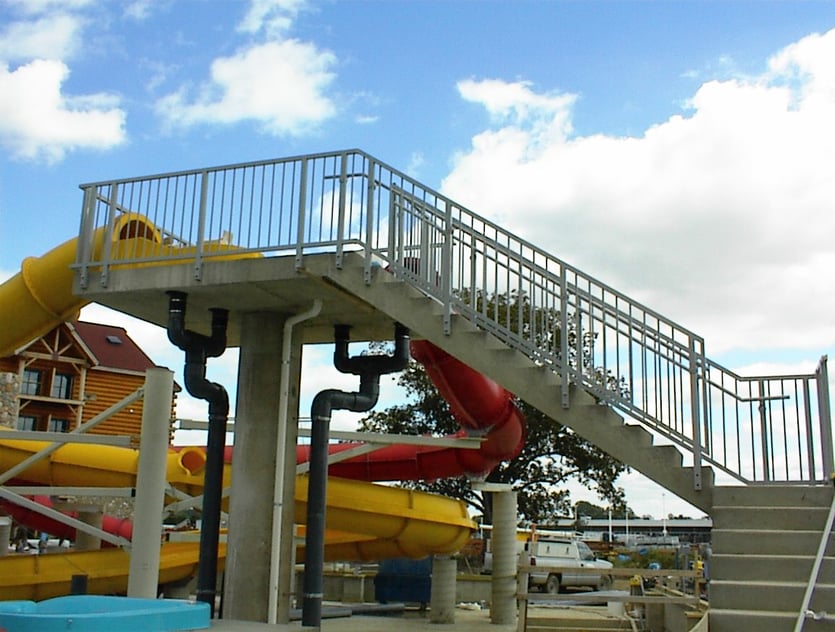In this guide, we will explore the pivotal role of architectural elements in building design,...
Architectural Metal Railings: Options and Alternatives
In this guide, we will explore the pivotal role of architectural elements in building design, focusing on the significance of metal railings. We'll delve into the material choices available and the factors that should guide your selection. Finally, we'll introduce a compelling alternative material for architectural metal railings, fiberglass reinforced plastic (FRP), and its numerous advantages.

Architectural Metal Railings Like this Wrought Iron Example Can Add Elegance and Charm to a Home's Exterior |
Four Factors Shaping Architectural Metal Railing Material Selection
- Durability and Weather Resistance
Some metals withstand weather conditions better than others, making the environment a powerful factor for consideration.. - Maintenance Requirements
Steel railings require regular painting or coating to prevent rust and corrosion, while aluminum railings are comparatively low-maintenance. - Budget Considerations
Some materials may have higher upfront costs, they may offer long-term value due to their durability/low maintenance. Metal commodities vary in price over time. For example, steel has historically experienced significant cost volatility that can impact decision-making. Aluminum may be less expensive up front, but may dent or bend more easily than steel, leading to substantial maintenance or replacement costs. - Balancing Aesthetics and Functionality
Consider how the material aligns with your design vision while meeting safety and durability requirements.
With these four factors in mind, we can examine each of the metal options available.
Pros and Cons of Architectural Aluminum Railings
- Aluminum railing pros may include (depending on material quality) can include durability, lighter weight, low maintenance, a modern, sleek aesthetic, and the fact that aluminum can be a recyclable material. These railings are often powder coated, making them resistant to weathering. Aluminum is also recyclable, giving it some appeal in terms of sustainability.
- Cons on aluminum include lower strength (generally not as strong as steel). The raw material cost of aluminum is typically higher, but the cost of finished railings may vary.
Pros and Cons of Steel Architectural Railings
- Steel comes with a number of pros, including strength and durability, security, variety, and value.
- This material also has its share of cons, including maintenance (regular painting or coating is often required to prevent rust/corrosion), heavier weight, and the problem of corrosion if not properly maintained.
Pros and Cons of Architectural Wrought Iron Railings
- Many choose wrought iron for its pros, which can include durability, strength, aesthetic appeal, customizability, relatively low maintenance, and security (it can provide an added layer of security, especially for elevated areas or staircases, acting as effective deterrents against unauthorized access).
- Like other metals, wrought iron has its cons as well, including cost. This material tends to be more expensive upfront compared to some other, more common railing materials. The material itself and the labor required for fabrication and installation also affect costs. While it is often viewed as low maintenance, it still can rust over time, especially in areas with high humidity or near saltwater. Weight, heat absorption (the material becomes hot to the touch), and limitations on design flexibility also factor in.
Fiberglass Reinforced Plastic (FRP): An Ideal Alternative to Architectural Metal Railings
While metal railings are in common use, composite materials have been gaining ground over the past 50 years. Fiberglass reinforced plastic (FRP) is gaining popularity as an ideal alternative to traditional architectural metal railings. FRP combines strength, durability, and design flexibility, making it a versatile choice for a wide range of applications.

FRP Railing Application in an Amusement Park |
These are some of the best known benefits of fiberglass reinforced plastics for railings.
- Durability: Highly resistant to corrosion, rust, and weathering, ensuring they remain in top condition over time.
- Strength: Despite being lightweight, FRP railings offer an exceptional strength-to-weight-ratio for robust safety and security features.
- Customizability: FRP railings can be tailored to match specific design requirements. They are available in various colors and finishes.
- Low Maintenance: FRP railings require minimal maintenance, reducing long-term costs and upkeep efforts.
- Non-Conductive: Suitable for applications where electrical conductivity or heat conduction are concerns.
- Lightweight: FRP railings are lightweight, simplifying transportation and installation.
- Environmental Friendliness: FRP can be a sustainable, eco-friendly material choice, especially since it is designed to outlast many metal railings.
If you are considering FRP as an alternative to metal railings, your local Fibergrate sales representative to get expert guidance in selecting the perfect railing solution to meet your needs. Contact us today to explore the world of FRP architectural railings and revolutionize your building's design and safety.


